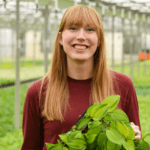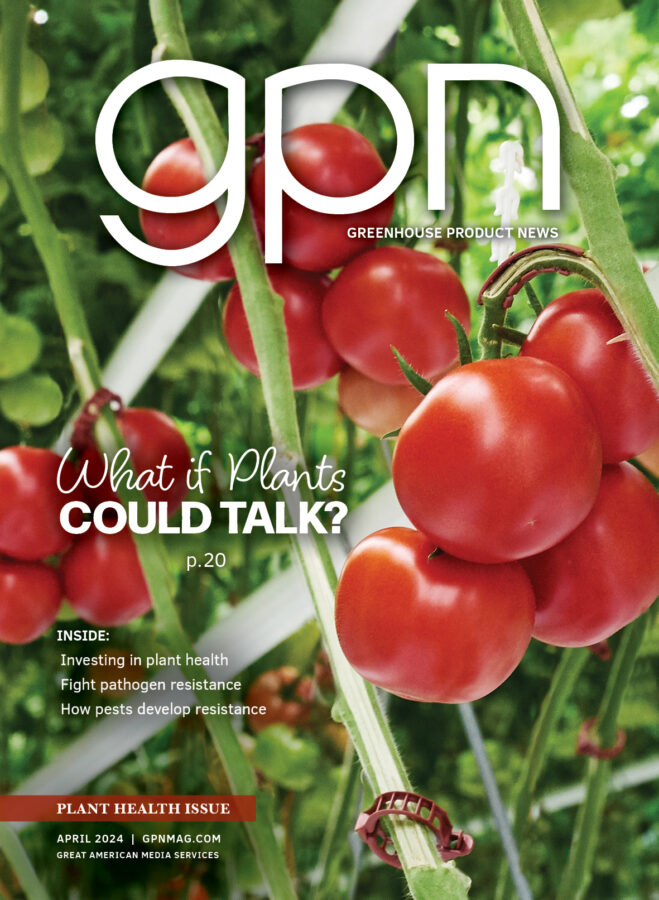Duets: Crop Nutrition and Organic Production
Growers reading this column likely fall into one of the following groups. Some currently practice organic crop fertilization. Others are interested in learning how to transition from traditional inorganic practices to organic. And others are satisfied practicing traditional crop fertilization.
Joining me is Kimberly Williams, professor of greenhouse management at Kansas State University. Kim and I have crossed paths at grower conferences for many years. She started working in organic crop nutrition in the late 1980s when she evaluated a variety of organic waste products from industrial processes as potential slow release nutrient sources for container production as part of her graduate research at North Carolina State University.
Peter: Kim, to make sure we all start on the same page, describe your view of organic crop production and how it differs from traditional production.

Kim: That’s a good starting point, Peter. There’s more than one way to think about organic crop production. The National Organic Program, managed by the U.S. Department of Agriculture (USDA), provides the legal definition of organically certified crop production, which limits inputs to exclude bioengineered plants; most conventional pesticides; and synthetic fertilizers and sewage sludge. The National Organic Standards Board (NOSB) describes organic agriculture as production that “promotes and enhances biodiversity, biological cycles and soil biological activity … based on minimal use of off-farm inputs.”
Another way to think about organic production, and especially organic fertilization, is by way of organic chemistry. Organic fertilizers contain nutrients that are bound in organic forms, which means they are components of carbon-based molecules. The carbon provides fuel for microbial activity. Synthetic fertilizers, on the other hand, are inorganic — they are simple salts that are easy to measure and manipulate.
Peter: Thanks for that foundation, Kim. The two official definitions are interesting in that USDA states what inputs are not allowed, whereas the NOSB definition links organic production to biological activity, biological cycles and biodiversity. As I consider the emphasis placed on biology, the words natural and nature come to mind.
After a career’s worth of monoculture-centric production in my own greenhouse, I’ve found that it takes some mental fortitude to flip a switch from trying to control nature to embracing nature’s complex diversity. Years ago a television commercial had the tag line, “You can’t fool Mother Nature.” After decades of trying to control her, we’re finally accepting another popular adage, “If you can’t beat them … join them.” I believe we’re making progress.
Next, help us understand how traditional growers may already be practicing certain organic principles, including non- nutrition practices, without being certified as organic.
Kim: There are many practices of traditional growers that contribute to sustainable crop production, regardless of organic certification. Some that come to mind are the increasingly common use of biological controls to manage arthropod and disease pests as opposed to applications of synthetic pesticides; using cultural practices to manage crop height instead of chemical plant growth regulators; reducing fossil fuel consumption; reducing water and fertilizer use; and reducing or eliminating the use of plastics. Growers are adopting these sustainable practices because they make sense from a marketing and/or economic strategy.
Peter: Your mention of adopting sustainable practices because they make sense brings to mind something I heard years ago regarding protection of the environment. The expert stated that making decisions that protect the environment is always good for business in the long run. I think of clean air and clean water, is there a price too high to ensure public safety?
Our industry is in a transitional period where traditional pesticide use is declining in favor of natural, organic and biological products. Reasons for the shift include worker protection and consumer demand. Fewer growers continue to argue that adopting sustainable practices is bad for business. And from the research world each experiment, project and collaborative effort adds a deeper level of understanding of nature’s complex biological balances.
Kim, from your perspective is organic growing sustainable? Is inorganic? What do we consider sustainable to be regarding inputs, outputs and economics?
Kim: One of my favorite definitions of sustainable crop production was put forth by the American Society of Agronomy in the late 1980s: Sustainable production, “over the long term, enhances environmental quality …; is economically viable; and enhances the quality of life for [growers] and society as a whole.” Adoption of sustainable production practices is essential for the future of our industry.
We know how to grow crops with less water, fertilizer and fossil fuels — and now growers are beginning to adopt available technologies when it makes economic sense for the operation or market demand dictates the changes. I see organic-certified production as more challenging because of the costs and red tape associated with certification processes. I know growers who use organic methods but don’t bother with the paperwork because they haven’t found a marketing or economic advantage.
Of course, our industry has growers along the entire continuum from traditional to thoughtfully sustainable to certified organic. One of the things that I find interesting, knowing some of the same growers over the past twenty years, is how their perspectives have changed to embrace more sustainable, if not organic, crop production practices. Peter, you’ve been serving our industry longer than me — what is your perspective?
Peter: I have a perfect illustration of your point, Kim. My father told the story of dusting our cabbage crops with my grandfather, his father-in-law, before breakfast when the morning dew would absorb the dust. Back then in the 1950s they were dusting with DDT! Set that as the beginning of the continuum you reference. Years later I have my own story as a teenager spraying our trellis tomato crops. With the tractor and sprayer heading in one direction the breeze carried the spray away from me. But turning around and heading down the row in the opposite direction carried the spray drift right into me. Follow the continuum to the Worker Protection Standard; we’ve come a very long way.
How about specific organic fertilizers, what types of products are out there?
Kim: A range of products are now on the market, both as slow-release fertilizers and liquid fertilizers. Organic fertilizers support microbial activity, and this is an advantage in that a healthy microbial population in the substrate can outcompete pathogenic organisms and therefore provide some protection from root diseases. But this microbial activity is a disadvantage outside of the container where organisms may grow on walkways and in pipes and fertilizer tanks.
One of the areas that has always interested me is the possibility of using waste products as nutrient sources. Today, we have a variety of carefully-manufactured organic fertilizers from waste streams of food processing industries that provide reliable nutrient release from batch-to-batch, but there is still work to be done to make them as straight-forward to use as inorganic fertilizers.
Peter: Having to deal with algae, biofilm and other microbial contamination can be more challenging with organic fertilizers. Fortunately, we have a range of sanitation products capable of managing the situation. Kim, let’s shift to hydroponics. Why is this arena in the news?
Kim: The topic of organic hydroponics is definitely controversial. Whether or not hydroponic production will be allowed to be certified organic is currently being debated at the national level. It is not allowed in the European Union.
Peter: What is it about hydroponic production that disqualifies it?
Kim: Opponents argue that hydroponics systems do not align with a founding principle of organic production, which is to “feed the soil, not the plant.” That is, soil biology and health is a central focus of organic production, and hydroponics eliminates the soil. While there are liquid organic fertilizers that are being used in hydroponics systems, inorganic nutrients are the norm in hydroponics for many reasons.
Peter: In my opinion, we are at a moment of truth in this debate. Hydroponic vegetable and herb production will continue to increase as controlled environment agriculture expands. You used the phrase “thoughtfully sustainable” earlier. My phrase is sensibly sustainable, our brains are thinking similarly. Let’s say a grower isn’t all the way to organic and reaches 90 percent qualification. He otherwise follows sensible, sustainable practices. It could be a hydroponic grower following every organic rule except one, there’s no soil. Is it the market’s responsibility to sort through the gray area?
And speaking of the market, what about the consumer? How are consumers driving the organic movement and will they accept hydroponically grown food?
Kim: Time will tell. For edible crops, such as leafy greens, use of liquid organic fertilizers in hydroponics has the potential to reduce nitrate levels in the leaves, and this is a potential benefit from a human health perspective. Nutrient sources also influence taste of leafy greens. There are opportunities to develop market niches based on the palates and preferences of different chefs and consumers.
Peter: Kim, you and I have been educators for some time and enjoy the process of teaching. We have an opportunity to teach growers and consumers about how our knowledge in this arena is growing. Whether a crop is grown organically, thoughtfully or sensibly sustainably, or traditionally, more education is needed to allow all to make informed decisions.
Kim: Sensibly sustainable makes sense to me; and this is how organic hydroponic growers will have to go if the production system is not allowed for use in organically-certified crops. In a broader sense, though, “sensibly sustainable” is just good business. Here are two examples: one grower in my region rarely uses plant growth regulators; instead, he relies on cultural practices like drought stress and brushing transplants to manage bedding plant growth. By minimizing his use of chemicals, he is thinking about not only his current employees’ health and well-being, but also future generations. And he has turned this philosophy into a component of his marketing strategy that distinguishes his product from big box stores. Another operation in the Midwest has switched over to sole use of biologicals this spring because his market is responding to a ‘no pesticides’ message.
Peter: Thank you for joining me Kim, your insights are helpful.


 Video Library
Video Library 




















